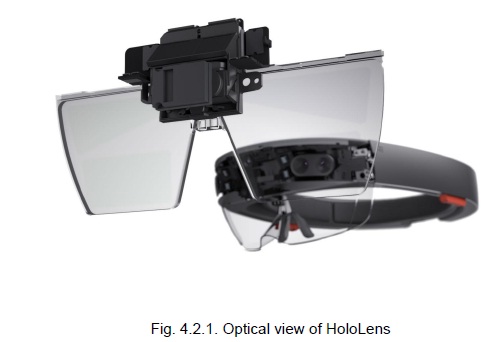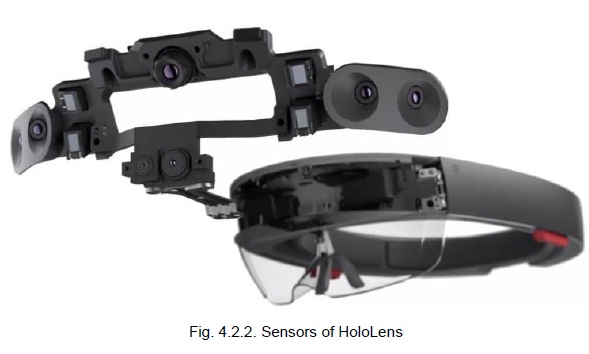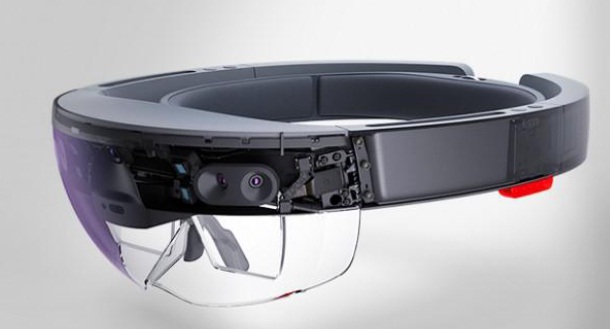Microsoft HoloLens | Seminar Report and PPT for CSE Students
Microsoft HoloLens | Seminar Report and PPT for CSE Students
Microsoft HoloLens seminar examines the new technology of Holographic Projections (Microsoft HoloLens). It highlights the importance and need of this technology and how it represents the new wave in the future of technology and communication, the different application of the technology the fields of life it will dramatically affect including business, education, telecommunication and healthcare.
The paper also discusses the future of holographic technology and how it will prevail in the coming years highlighting how it will also affect and reshape many other fields of life, technologies and businesses.
HoloLens is essentially a holographic computer built into a headset that lets you see, hear and interact with holograms within an environment such as a living room or an office space. It is based on Augmented reality, Augmented reality (AR) is a live direct or indirect view of a physical, real-world environment whose elements are augmented (or supplemented) by computer-generated sensory input such as sound, video, graphics or GPS data. The history of augmented reality can be traced back to 1990 and work undertaken by Professor Tom Caudell as part of a neural systems project at Boeing. This project was focused upon finding new ways to help the company’s engineering process and involved the use of virtual reality. Augmented reality is the blending of virtual reality and real life, as developers can create images within applications that blend in with contents in the real world. With AR, users are able to interact with virtual contents in the real world, and are able to distinguish between the two.
INTRODUCTION:
Microsoft HoloLens, known under development as Project Baraboo, is a pair of mixed reality head-mounted smartglasses developed and manufactured by Microsoft. HoloLens is essentially a holographic computer built into a headset that lets you see, hear and interact with holograms within an environment such as a living room or an office space. It is based on Augmented reality, Augmented reality (AR) is a live direct or indirect view of a physical, real-world environment whose elements are augmented (or supplemented) by computer-generated sensory input such as sound, video, graphics or GPS data. The history of augmented reality can be traced back to 1990 and work undertaken by Professor Tom Caudell as part of a neural systems project at Boeing.
This project was focused upon finding new ways to help the company’s engineering process and involved the use of virtual reality. Augmented reality is the blending of virtual reality and real life, as developers can create images within applications that blend in with contents in the real world. With AR, users are able to interact with virtual contents in the real world, and are able to distinguish between the two.
3D Holographic Technology
Holography is a diffraction-based coherent imaging technique in which a complex three-dimensional object can be reproduced from a flat, two-dimensional screen with a complex transparency representing amplitude and phase values. It is commonly agreed that real-time holography is the ne plus ultra art and science of visualizing fast temporally changing 3-D scenes. The integration of the real-time or electro-holographic principle into display technology is one of the most promising but also challenging developments for the future consumer display and TV market. Only holography allows the reconstruction of natural-looking 3-D scenes, and therefore provides observers with a completely comfortable viewing experience.
A HoloLens will use holographic technology to project large-scale, high-resolution images onto a variety of different surfaces, at different focal distances, from a relatively small-scale projection device. To understand the technology used in HoloLens, we must understand the term ‘Hologram’, and the process of making and projecting holograms. Holography is a technique that allows the light scattered from an object to be recorded and later reconstructed. The technique to optically store, retrieve, and process information. The holograms preserve the 3-D information of a holographed subject, which helps to project 3D images.
Microsoft HoloLens
HoloLens is essentially a holographic computer built into a headset that lets you see, hear, and interact with holograms within an environment such as a living room or an office space. Microsoft has built the headset without the need to be wirelessly connected to a PC, and has used high-definition lenses and spatial sound technology to create that immersive, interactive holographic experience. The HoloLens comes with semitransparent holographic lenses which ‘generate multi-dimensional full-colour holograms’. That means it’s not going to be projecting images into a room that everyone can see. It’s cutting edge stuff, but it’s not quite that advanced yet. Basically HoloLens is a high-tech computer system that can be wearable and works according to your gestures with hands, eyes, etc.
As seen in above fig. 3.1, That is actual picture of wearable augmented reality from Microsoft named by HoloLens. This is the first holographic computer which is running on Windows 10. It is completely unattached as no wires, phones or computers needed, it is a computer itself. The premier device for Windows Holographic, Microsoft HoloLens is a smart-glasses headset that is a cordless, self-contained Windows 10 computer. It uses various sensors, a high-definition stereoscopic 3D optical head-mounted display, and spatial sound to allow for augmented reality applications, with a natural user interface that the user interacts with through gaze, voice, and hand gestures.
Codenamed “Project Baraboo,” HoloLens had been in development for five years before its announcement in 2015, but was conceived earlier as the original pitch made in late 2007 for what would become the Kinect technology platform. It was introduced with operating systems, such as Android, iOS and OS X on April 5, 2016. Microsoft has targeted HoloLens for release “in the Windows 10 timeframe,” with the Microsoft HoloLens Development Edition to begin shipping March 30, 2016, Microsoft has not set a time frame for consumer availability of HoloLens, with HoloLens chief inventor Alex Kipman stating that HoloLens will have a consumer release only when the market is ready for it. Companies such as Samsung Electronics and Asus had expressed interest in working with Microsoft to produce their own mixed-reality products based on HoloLens
Working of HoloLens
Microsoft hololens has user interface so it takes voice, gaze and gestures as input command. Than internal computer works on input command. Now projection of hologram, for projection hololens use the HUE(head up display) method two nanoprojector located at each side of head and semi transparent visor which reflect the image as light on users eye. Microsoft explains the holographic element in this way: “The key to a great holographic experience holograms that are light point rich, i.e. have a high holographic density, and are pinned or anchored to the world around you. To achieve this, HoloLens has been designed for optimal holographic density of 2.5K radiants. The more radiant and light points there are, the brighter and richer the holograms become.” We here divide it in three parts to make easy to understand, in one of them we study the major hardware parts of it, and specification than we will move to the real world example of augmented reality based HoloLens.
Parts of HoloLens
It have a major six parts those are bone of this product Camera, Computer, Lenses, Vent, Sensor, Buttons. Let us study them one by one:
Camera :
The project HoloLens depth camera has a field of vision that spans 120 by 120 degree, so it can sense what your hands are doing even when they are nearly outstreached.
Computer :
HoloLens is not just a visor connected to a computer, it is a computer on its own. HoloLens contain CPU, battery,GPU and first of its kind HPU (holographic processing unit). 18 sensors flood the brain of the device with terabyte of data every seconds.
Lenses :
Microsoft HoloLens has two display. They are transparent so that wearer can see the real world behind virtual object. To create project HoloLens image, light particles bounce around millions of times in the so called light engine of the device. Then the photons enter the two lenses(one for each eye), where they ricochet between layers of glasses before finally hitting of wearer eye.
Vent :
The device is more powerfull than a laptop but won’t overheat- warm air flows to the sides, where it vents up and out.
Sensor :
Sensor track where the wearer is looking and adjust the display. Motion sensor detect wearers movement. The sensor can also see wearers hands, the hands are an input system: user can interact with whatever he sees by just touching it. Wearer also give gesture as input sensor enables the tracking of user movement.
Buttons :
On the right side buttons allow user to adjust the volume and to control the contrast of the hologram.
Specification of HoloLens
Optics

See through holographic lenses (Waveguides)
2 HD 16:9 light engines.
Automatic pupillary distance calibration.
Holographic Resolution : 2.3 total light points.
Holographic Density: > 2.5 radiants (lights point per radian).
Sensors

1 IMU
4 environment understanding cameras
1 depth camera
1 2MP photo / HD video camera
Mixed reality capture
4 microphones
1 ambient light sensor
Human Understanding
Spatial sound
Gaze tracking
Gesture input
Voice support
Input / Output / Connectivity
Built-in speakers
Audio 3.5mm jack
Volume up/down
Brightness up/down
Power button
Battery status LEDs
Wi-Fi 802.11ac
Micro USB 2.0
Bluetooth 4.1 LE
Power
Battery Life
2-3 hours of active use
Up to 2 weeks of standby time
Fully functional when charging
Passively cooled (no fans)
Real-life working of HoloLens
The HoloLens comes with semitransparent holographic lenses which ‘generate multi-dimensional full-colour holograms’. That means it’s not going to be projecting images into a room that everyone can see. It’s cutting edge stuff, but it’s not quite that advanced yet. In much the same way as Google’s ill-fated Glass experiment, the HoloLens will interject virtual elements onto your vision. That means it’s different to virtual reality headsets such as the HTC Vive, Oculus Rift, and Playstation VR. These VR headsets immerse you in a fully simulated world, whereas the HoloLens uses the real world as a canvas on which to overlay virtual elements.
Microsoft explains the holographic element in this way: “The key to a great holographic experience is holograms that are light point rich, i.e. have a high holographic density, and are pinned or anchored to the world around you. To achieve this, HoloLens has been designed for optimal holographic density of 2.5K radiants. The more radiants and light points there are, the brighter and richer the holograms become.
CONCLUSION:
The premier device for Windows Holographic, Microsoft HoloLens is a smart-glasses headset that is cordless, self-contained Windows 10 computer. It uses advance sensors, a high-definition stereoscopic 3D optical head-mounted display, and spatial sound to allow to augmented reality applications, with a nature user interface that the user interact with trough gaze, voice and hand gestures that gives you ways to go beyond the screen, so see your world as a canvas, and gives you more natural way to interact. HoloLens is a thing where you can connect, create and explore like never before, Create what you imagine, visualize your work, collaborate and explore. HoloLens with Holographic processing unit, sensor fusion, power and grace, advanced optics, build in speakers, spatial sound gives you the new augmented or virtual world over real world. Without bumping to walls you can watch NetFlix, play Minicraft, use AutoCAD, talk to Dad on Skype, design a brand new car, and so on…
BIBLIOGRAPHY:
1. Pandher, Gurmeet Singh (2 March 2016). “Microsoft HoloLens Preorders: Price, Specs Of The Augmented Reality Headset.”. The Bitbag. (thebitbag.com)
2. “Microsoft Hololens hardware”. Microsoft. Retrieved 1 May 2015. (microsoft.com)
3. Microsoft HoloLens – Here are the full processor, storage and RAM specs, Windows Central, May 2, 2016 (windowscentral.com)
